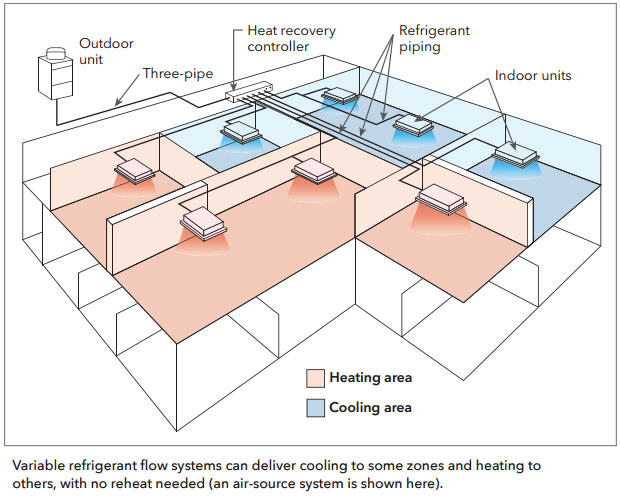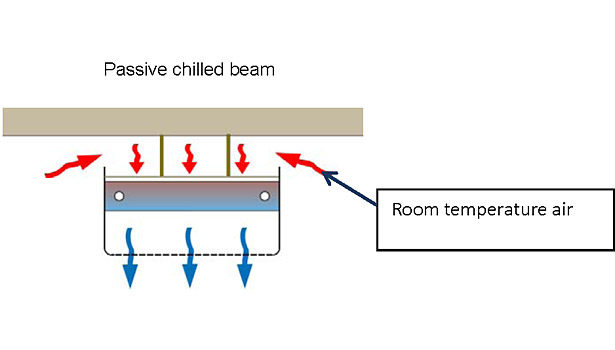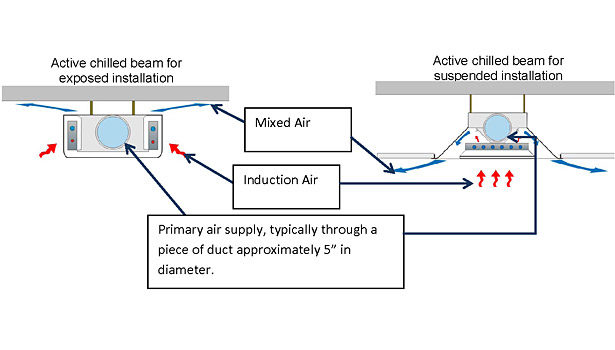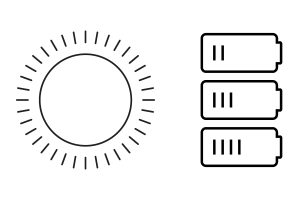Introduction
Energy conservation and energy recovery strategies can be used to reduce reliance and overall use (cost) of a building’s HVAC system. These strategies can involve mechanical systems, heat transfer methods, building automation systems, and building commissioning.
Energy Use
The amount of energy used by a typical building’s HVAC system is about 40-60% of its overall energy consumption. This is heavily dependent on type, climate, design, building use, and efficiency of the system.
- Some type of mechanical system is typically always involved in buildings regardless of size, so using energy-efficient mechanical systems is a good strategy for energy conservation.
- The National Appliance Energy Conservation Act of 1987 set minimum energy efficiency standards that all small and large heating and cooling equipment needed to follow. Generally speaking, heating and cooling equipment keep getting more efficient with technology upgrades, however, they also tend to have more parts like circuit boards that may fail.
Recovery Strategies
Dual-Condenser Cooling
Dual condenser cooling is a system that uses two refrigeration circuits (instead of one), each with its own condenser, evaporator, and compressor. One circuit regulates the flow of refrigerant from the condenser to the evaporator based on the evaporator’s heat load, while the other circuit has a constant refrigerant flow. Dual condenser cooling systems can be used as air conditioning systems or heat pumps.
- Provides serviceability and Longevity: For example, one condenser can be taken offline (or break) and the other is able to still maintain close temperatures needed for the space to still function.
- There are various systems that use different methods. Can include the use of multiple chillers instead of a single chiller.
- The system essentially uses and directs coolant in whatever way is most efficient given the load requirements and environment/weather.
Absorptive Cooling (Absorption Chillers)
Absorption cooling is a thermally driven system that uses thermal energy to produce cooling. It uses heat instead of electricity, so it’s a much better option when electricity is expensive or scarce. This heat source can be provided by steam, natural gas, solar heated water, geothermal water, or resistance heating.
- Absorption chillers do not have a compressor, so they are quiet and more reliable
- They are able to utilize waste heat
Gas-Fired (Natural Gas)
Absorption chillers are generally operated by natural gas. This is generally a more economical fuel than electricity.
They do not rely on refrigerants (ozone depleting).
Solar-Powered
Powering an absorptive cooler by hot water from solar collectors is an easy way to make them more efficient
Standard flat-plate solar collectors can supply water from 175 deg to 195 deg
- This can be even higher if supplied with a parabolic solar collector focuser, but this is a ‘feature’ and takes up more space.
Solar Powered Desiccant Cooling
Cooling system uses desiccants to dehumidify and cool air by means of evaporative cooling. A desiccant is a material, either liquid or solid, that absorbs water. These are those little packets that come in some shipping boxes with items to keep moisture away from the object. They also are found around IGUs.
- Typical materials; silica gel, zeolite, lithium bromide, and monoethylene glycol.
- Dehumidifying temperature (lower relative humidity) = Feeling cooler at same temperature
Typical design has a system pass incoming air over a desiccant, which is usually mounted on a wheel rotating in the airstream or is a pad/block of some sort. As the air passes over/through the desiccant medium, it’s dehumidified and therefore cooled. Thermal energy from solar collectors is used to dry out the desiccant so that it can be used again and the cycle repeated.
- In the above diagram, this system is combined with an evaporative pad to add humidity back in for the greenhouse.
Direct Contact Water Heaters
Passes hot gas directly through water to heat it. Natural gas is burned to create flue gas that transfers heat to the water. To further improve efficiency, a heat exchanger on the combustion chamber reclaims any heat lost from the chamber. Water that is in direct contact with the gas is still considered safe for human consumption.
- Direct contact water heaters are up to 99% efficient when the inlet water temperature is below 59 degrees F.
- Direct contact water heaters are a high-cost alternative, they are best used where there is a continuous demand for hot water, such as for food processing, laundry and industrial purposes.
Direct Contact Water Heaters
Passes hot gas directly through water to heat it. Natural gas is burned to create flue gas that transfers heat to the water. To further improve efficiency, a heat exchanger on the combustion chamber reclaims any heat lost from the chamber. Water that is in direct contact with the gas is still considered safe for human consumption.
- Direct contact water heaters are up to 99% efficient when the inlet water temperature is below 59 degrees F.
- Direct contact water heaters are a high-cost alternative, they are best used where there is a continuous demand for hot water, such as for food processing, laundry and industrial purposes.
Recuperative Gas Boilers – (Boiler Economizer)
This system recovers the heat in the flue gas that would normally be discharged to the atmosphere. A recuperative gas boiler is designed to cool the flue gas enough to achieve condensation, so that both sensible heat and latent heat are recovered.
- Reclaimed heat is used to preheat the cold water entering the boiler or to preheat combustion air.
- Standard gas boilers have max efficiency of 80-95%, a recuperative gas boiler has efficiency of 95%+.
Displacement Ventilation
Air distribution system in which supply air is dispensed at floor level and rises to return air grilles in the ceiling as it warms. With air delivered at floor level, close to users, it doesn’t need to be cooled as much.
It’s great at removing excess heat generated from the lighting in a space. Also delivers high indoor air quality levels because of the large amount of fresh air.
- It can be used with personal temperature control via underfloor wiring and other methods.
- Variation of the system places vents at exterior walls near the floor. This works for a depth from the facade for about 16’-0” before needing to be supplemented.
Considerations:
- This system typically requires a raised floor system, about 12” or more in order to accommodate the HVAC across an open space. For smaller rooms it requires the ducting to be below the floor, which may not be allowed or possible in condos or some buildings.
- If the floor is a raised system, the stairway and elevators need to be raised to this level, so there is an extra level of coordination needed to make this work in buildings. Really is only sometimes economical for commercial buildings. If implemented, it means the commercial space can easily adapt to new layouts.
- For infectious disease situations, it is typically better to have the air ducted from the ceiling (hospitals), so all airflow goes down to the feet rather than up to the face.
Closed Loop Water Heat Pumps
Uses a series of pumps for different zones of a building. These heat pumps are all connected to the same piping system of circulating water. The water loop is maintained at a temperature between 60 °F to 90 °F.
When some rooms are heating, others are sometimes cooling. The rooms which are cool are ‘ejecting’ their heat into the water loop, while the heating rooms are heating from the water loop.
Therefore, the heating zones are extracting heat from the loop/leftover from the cooling zones. If the heating and cooling zones are balanced, there is no additional energy needed to be added to the system. This makes the system extremely efficient when there are balanced requirements for heating and cooling.
- This system is not appropriate when cooling loads are small
- Closed loop systems provide individual room or zone control.
- Ventilation is ductless so it’s extremely efficient with no conditioned energy lost during air travel.
Variable Refrigerant Flow Systems
Variable refrigerant flow (VRF) uses a single compressor and condenser unit located outdoors, connected to multiple evaporators located in different zones of the building. Refrigerant is supplied to each zone instead of the chilled and heated water (in typical systems).
- Only the amount of refrigerant delivered to each zone is what is needed for that system/area. This reduces overall energy consumption.
- Ideal for buildings with different loads and different zones. Hotels, Schools, Multifamily residential, and office buildings.
- Are not appropriate for buildings with large open volumes: theaters, gyms, arenas.
- Allows flexibility in the install locations, and ability for building monitoring systems to individually monitor.
- Very similar to the ability of a closed loop water heat pump, however it uses refrigerant instead of water.
Thermal Energy Store
Uses water, ice, rock beds, or another engineered medium to store excess heat or coolness for use at a later time. This helps negotiate large temperature swings throughout the day and soften them.
- Ice can absorb and give off more heat than other storage media.
- Can help with energy costs that can be variable during the day. Utilize cheaper energy costs overnight or off-peak hours to chill/heat to be used during more expensive peak times.
In Summer:
Chillers can cool water at night, when utility rates are typically lower, and the cooling needs of the building are not as great as they are during the day. During the next day, the coolness that is stored can be used to cool the building and then supplemented as required.
In Winter:
Boilers can heat water or a medium. This heat is stored and then can passively let the heat radiate out. If you ever take a warm bath. It’s common to leave the warm bath water in the tub, letting it passively heat the room.
Airside Economizer Cycle (Cooling in mild/cool weather)
Economizer Cycle takes outdoor air and mixes it with recirculated (already conditioned) indoor air. This is in contrast to systems that take exclusively outside air and condition it.
This occurs when the outside air temperature is below the inside air temperature and therefore will use less energy to cool it than mechanical cooling. This reduces the energy needed for conditioning the air. As the temperature drops, less air is introduced because it means more energy is needed to condition. The amount of air which is introduced is controlled by a circuit board which opens and closes different dampers using a combination of sensors that are located inside and outside the building.
- Basically equivalent to an open window, however the advantage being that it filters the air and distributes it throughout the building via the MEP system.
- For larger office buildings, economizer cycles can significantly reduce energy consumption.
- The economizer reduces air conditioning costs by using outside air (OSA) for “free” cooling causing the compressor to run less. air (OSA) for free cooling causing the compressor to run less
- Pressure can become a concern inside the building if not enough air is exhausted and should be addressed in some way. The damper/exhaust can occur on a larger system wide setting or via individual spaces.
- Useful during nighttime cool temperatures
Energy Recovery Ventilators (ERV) – Air to Air Exchangers
Reclaim waste heat energy from the exhaust air stream and use it to condition incoming fresh air. This can reduce the energy needed to condition incoming air by 60 to 70%. This requires a system that has exhaust air. Very similar to an economizer, however, it transfers heat and moisture while the economizer mixes.
These systems are very efficient in very cold, very hot, or humid climates where the temperature differential between the outside and inside is very large.
Very efficient in continuously occupied buildings such as hospitals.
- Similarly, their use is not normally justified in temperate climates or buildings that are not occupied at all times.
These systems ultimately have some leakage between the mixing of exhaust and supply air. The International Mechanical Code prohibits recirculation of exhaust air into a mechanical system, but it does allow for up to 10% which allows this leakage to comply.
- Prohibited in hazardous environments, places that exhaust flammable vapors, dust, commercial kitchens. Air with excessive grease, moisture, and other contaminants should be kept separate.
- The exhaust and intake must be kept as far away as possible to not have contamination (hard because they do need to make contact with each other at some point before leaving the building).
- Defrosting the air in the winter may need to occur (as warm air gives up its heat (and cools), the colder it gets the more likely it will condense.
Flat Plate Heat Recovery Units
The ducts are arranged to be adjacent to each other and are separated by a thin wall. The thin wall helps facilitate heat transfer.
- Only transfers sensible heat (temperature) and not humidity.
Energy Transfer Wheels (Enthalpy Heat Exchangers)
Transfers heat between two airstreams by using a ‘wheel’. The wheel is set perpendicular to the airflow, with the center of the wheel between the ducts. The wheel is impregnated with a substance which ends up absorbing moisture and transferring it to the other airstream as it spins.
- Transfers sensible and latent heat
- Typical in commercial buildings
Water to Water Heat Exchangers
Water to water heat exchangers, sometimes called runaround coils. Use water or some other liquid transfer medium to exchange heat.
- This allows the intake and exhaust vents to not be adjacent.
- Commonly used in large buildings
- Eliminate the possibility of the incoming air to be contaminated with exhaust air.
- Efficiency: 50-70%
Extract Air Windows
Uses a double-paned insulated window glass unit over which another pane of glass is placed inside the building. Air is drawn up between the two glazing plans.
This warms the glass in the winter and cools it in the summer, eliminating the need to separate out a perimeter heating system. Very uncommon system to encounter.
Ground Coupled Heat Exchanger (Geothermal)
Heat or cool outside air by circulating it through pipes buried in the ground.
During the summer the air can be directly used for cooling. In the winter, the air can help condition outside air prior to supplementing with extra energy to heat the building.
- Typically only suited for low rise buildings.
- Needs long runs of pipe in the ground. Installed either vertically if space is limited, or horizontally if there is an open field.
Chilled Beams
Chilled Beams: A ceiling mounted unit that uses water to provide heating and cooling. Has nothing to do with ‘structural’ beams.
Passive Chilled Beams
Relies on natural convection and can provide only cooling.
- Generally installed above a suspended ceiling
- Separate ventilation ducts are needed (does not handle ventilation)
- Temperature must be a bit higher than the dew point of the ambient room temperature so that condensation does not occur. This is not generally as cold as normally required with HVAC units, and therefore the chillers can be downsized, saving energy costs.
Active Chilled Beams
Integrated into the ventilation system and provides both cooling and heating. Fresh air is drawn into the unit where it is either cooled or warmed by water. The air is then forced out of the unit and into the room.
- Able to handle temperature control and ventilation.
Multi-Service Chilled Beam System
Combines an active chilled beam system with other building services such as lighting, sprinklers, data cabling and building management sensors.
- Generally have fewer parts requiring fewer maintenance. They have a high initial cost but generally offer significant energy savings.














Leave a Reply
You must be logged in to post a comment.